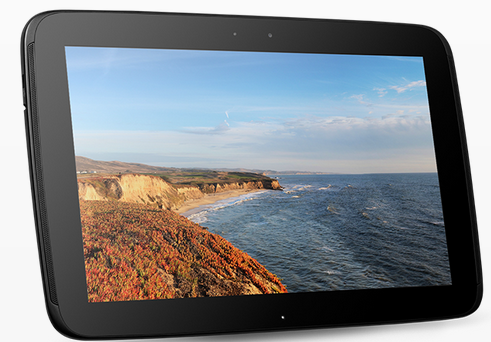
From a hardware perspective Google’s new Nexus 10 tablet compares favorably to the new full-sized Apple iPad with Retina display. The Nexus 10 is thinner and lighter, has a higher resolution screen and is $100 cheaper.
Of course hardware doesn’t tell the whole story. There are two important parts of the software narrative: the operating system and the apps.
While Apple has had a lot more time to perfect iOS than Google has with Android, it could be argued that Android’s new Jelly Bean operating system is pretty much on par with Apple’s iOS 6. Apple or Google fans can fight it out over minor differences, but both are smooth and fast. Apple has the advantage of controlling both the hardware and operating system while Google, like Microsoft, is mostly at the mercy of hardware makers. But the good thing about the Google Nexus brand is that even though it doesn’t actually build its own Nexus devices (the Nexus 10 is from Samsung while Google’s new Nexus 4 phone is from LG), Google does get to set all the specifications and make sure that its operating system is fully supported by the hardware.
Speaking of hardware, the Nexus 10’s A15 dual core processor provides more than ample performance and its 10.05 inch (diagnol) screen is stunning with its 2560 by 1600 resolution. With 300 pixels per inch, it’s even higher resolution than Apple’s highly rated Retina display.
Specs compared to iPad
The Nexus 10 weighs 602 grams (the 4th generation iPad weighs 652 grams) and it measures 263.9 by 177.6 by 8.9 mm compared to the iPad’s 241.2 by 185.7 by 9.4 mm, making the Nexus 10 actually a bit thinner than the equivalent iPad. Both are equipped with all recent versions of WiFi but unlike the iPad, the Nexus has NFC (near field communications) while the iPad has optional cellular versions Google just announced an HSPA (cellular) version of its Nexus 7 but the 10-inch model is so far WiFi only).
App wars
While Google is rapidly catching up with Apple when it comes to smartphone apps, Apple remains way ahead in terms of apps that are optimized for tablets. Apple says it has 275,000 iPad apps in its app store. Google doesn’t break it down tablet-optimized apps from phone apps, but I think it’s safe to say it’s way behind on tablet apps.
While the Nexus 10 can run phone apps, most just don’t look that great on the larger screen while Apple has done a great job convincing developers to adapt their apps for the iPad. And Apple smartly configured the iPad mini so regular iPad apps work without modification. One can’t say that same for Android’s highly fragmented eco-system where there are many different form factors and screen sizes.
But the fact that Apple runs more tablet apps is only important if there’s some you want that you can’t get. From my own perspective as a user, I have no trouble finding the apps that I want on my Nexus tablet but that’s because my tablet app needs are quite modest. What I mostly use tablets for is reading Kindle books, watching Netflix movies and checking email and there are excellent Android apps for those particular tasks. I am still waiting for Amazon to release its Android instant video app as it did for iPad this summer and as it has, of course, for its own Kindle Fire tablets. Of course if the killer app you want isn’t available, then all bets are off.
Do you really want a 10-inch tablet?
Personally, I’m happier with Google’s Nexus 7 tablet than I am with the 10-inch model. It’s easier to carry, lighter and I can even put it in some pants and coat pockets. That’s why I was glad to see Apple introduce the iPad mini and why I’m also happy with my 7-inch Kindle Fire HD. Though there are some advantages to a larger tablet (including a larger on-screen keyboard) there are times when smaller is bigger.